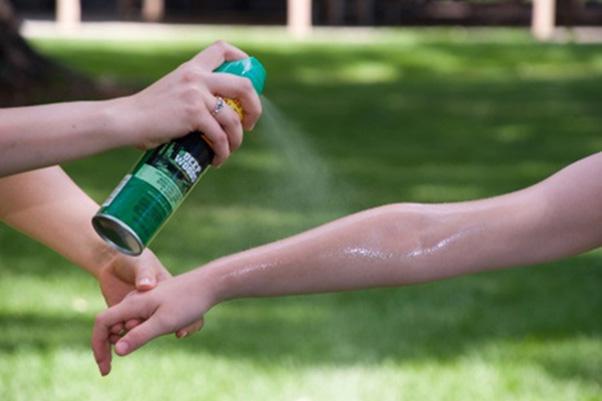During the summer months, along with rising temperatures and more daylight, comes the nuisance of mosquitoes, ticks, and other insects.
In the United States, mosquito bites are largely no more than an annoyance, but worldwide, mosquitoes transmit disease to more than 700 million people every year, according to the Annals of Internal Medicine.
The recent outbreaks of the Zika virus have made people especially wary of the risks of mosquito bites. Ticks can also spread diseases, the most common of which are Lyme disease and Rocky Mountain spotted fever.
The best way to avoid the threat of insect-borne disease is to prevent bites from occurring in the first place. There are several ways to do this, from insect repellants to wearing protective clothing to using bug netting.
Selecting Repellents
Insect repellents are the most popular option due to their ease of use. There are several different types of insect repellents, with varying active ingredients and methods of application.
Repellents containing DEET (N, N-diethyl-meta-toluamide) are generally the most effective and best-studied on the market. Available for public use since 1957, DEET has over 40 years of positive safety data, something few other compounds can boast.
According to the Annals of Internal Medicine, DEET concentrations from 5–35 percent provide adequate protection for most circumstances and a greater concentration correlates with longer-lasting protection. But once concentrations reach 50 percent, DEET’s protection does not significantly increase proportional to the increase in concentration. As such, concentrations of 35 percent and less are generally recommended.
DEET successfully repels mosquitoes, biting flies, chiggers, fleas, and ticks. Roughly 120 products containing DEET are registered with the EPA and come under several different brand names in lotions, pump sprays, creams, gels, aerosols, and towelettes.
Picaridin, another repellent option, has an effectiveness comparable to about a 10 percent DEET concentration. It’s nearly odorless and has no adverse effect on plastics.
Permethrin is an insect repellent used to treat fabrics, and it can be applied to clothing, shoes, bed nets, and camping gear. According to the Annals of Internal Medicine, it works as an insecticide, killing ticks, mosquitoes, and other arthropods on contact. Compared to fabric sprayed with DEET, permethrin-treated fabric can retain its potency for at least two weeks, even through several washings.
There’s also oil of lemon eucalyptus (p-Menthane-3, 8-diol, also known as PMD), a synthetic form of an ingredient in eucalyptus leaves and twigs. According to a National Center for Biotechnology Information review, oil of lemon eucalyptus gives protection similar to 10–25 percent concentrations of DEET.
A wide variety of plant-based repellents marketed as natural alternatives are also available. They contain mixtures of different plant oils, such as citronella, cajuput, lavender, safrole-free sassafras, peppermint, calendula, soy, and tea tree oils. Generally, they show only a slight effectiveness against repelling mosquitoes, providing about two hours of coverage.
Applying Repellents
The American Academy of Pediatricians (AAP) provides some tips for applying repellents. Skin-based repellents should not be applied under clothing; over cuts, wounds, or irritated skin; to the eyes or mouth; or excessively around the ears. To minimize eye and mouth exposure, spray the repellent on your hands first and then apply it to your face. (Do not follow this suggestion for children, as children frequently put their hands in their eyes and mouth.)
Repellents should also be administered in open areas to minimize inhalation and ingestion. Afterwards, be sure to wash repellent-treated skin with soap and water; otherwise, bedclothes and sheets could become contaminated with the repellent, leading to near-constant exposure.
The AAP does not recommend the use of products “that combine DEET with sunscreen. The DEET may make the sun protection factor (SPF) less effective. These products can overexpose your child to DEET because the sunscreen needs to be reapplied often.”
The Centers for Disease Control and Prevention, however, affirms that it’s OK—and, indeed, recommended—to use both a sunscreen and insect repellent when outdoors. “In general,” the CDC specifies, “the recommendation is to apply sunscreen first, followed by repellent.” Instead of using repellents on children under two years of age, use mosquito netting over baby carriers or strollers, and avoid dressing children in clothing with bright colors or flowery prints to minimize insect attraction.
Other Methods
Aside from repellents, there are other methods that can be employed to avoid bug bites.
In addition to wearing permethrin-treated clothing as mentioned above, minimize exposed skin by wearing long-sleeved shirts, long pants, and long socks, as well as tucking your shirt into your pants and your pants into your socks. You can also wear light-colored clothing to make it easier to spot ticks.
Reducing mosquitos in your yard will also minimize bites. Start by removing sources of standing water such as old tires or rain gutters, pots and buckets, plastic covers, toys, or other containers, as well as regularly changing the water in bird baths, fountains, rain barrels, or children’s pools—all of which are breeding grounds for mosquitos.
You can also put up houses for birds and bats—drawing animals that eat insects can further help control mosquito populations.
And when it comes to your home, ensure that there are no gaps at your doors and windows, and make sure all screens fit securely and are in good repair with no holes or tears.
By utilizing a combination of these repellents and tips, we can all enjoy our summers relatively pest-free.


